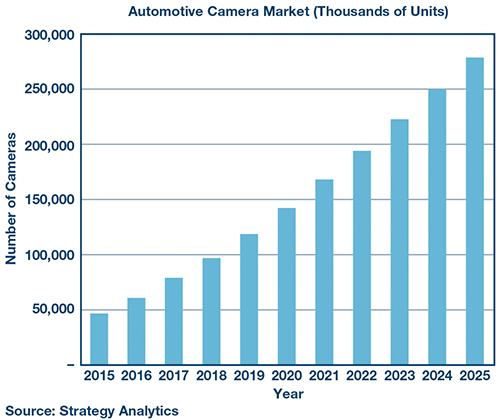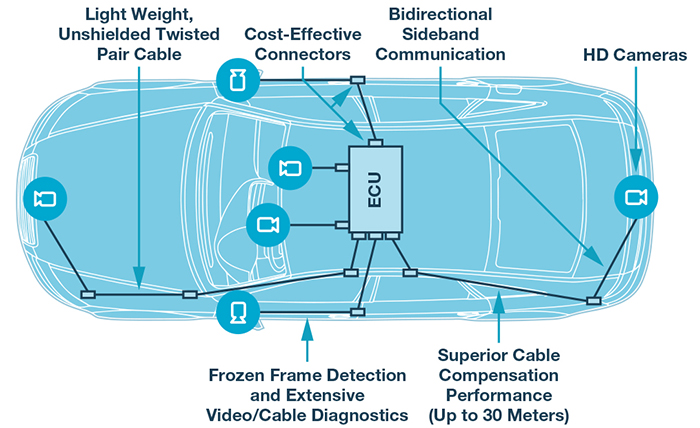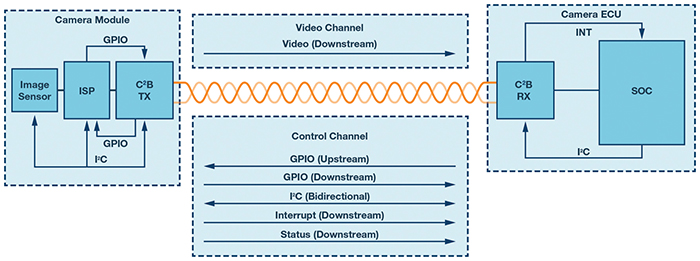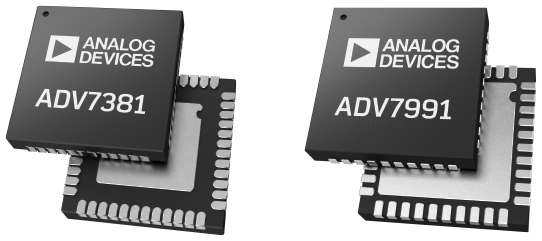A new camera link for automotive applications
As we hurtle toward the widespread use of autonomous vehicles, the need for more and more automotive sensors becomes ever more apparent. Cameras are one of the key sensors required to aid the evolution of the autonomous vehicle. Fionn Hurley, Analog Devices (ADI), discusses the company’s C2B.
The number of cameras in automobiles is rapidly increasing with new applications continuing to emerge. In addition to this, the take rate for camera applications continues to increase with camera-based applications moving from the preserve of lower volume premium vehicles to the larger volume standard vehicles market. Figure 1 shows the rapidly growing automotive camera market.
This growth trend is expected to continue beyond 2025 with vehicles supporting up to 20 cameras becoming a reality in the not too distant future.
Along with the number of cameras increasing, the need for higher camera resolutions continues at pace. This resolution increase is driven by two main factors. The first factor is the need to support more ADAS features, as these features require higher resolution to achieve greater and more accurate functionality. The second factor is the need to display higher quality images as consumers now demand excellent visual quality comparable to their smartphone’s high resolution displays.
The problem here is that the lifetime of a smartphone is significantly shorter than that of a car and, therefore, automobile manufacturers need to ensure they implement the latest display technology at the start of production so that their display systems stay relevant for as long as possible.

Above: Figure 1. The automotive camera market
Original equipment manufacturers (OEMs) continue to increase the size and resolution of the displays they use. As a result, when displaying a camera image on these larger and higher resolution displays, higher resolution cameras are required because using existing standard definition (SD) cameras results in a very poor user experience. A low resolution camera results in poor video quality. Additionally, many unwanted visual artefacts such as dot crawl and colour leakage are clearly visible on these displays - therefore, using SD cameras to drive these displays is no longer acceptable. To provide a better customer experience, high definition (HD) cameras are required.
The addition of these cameras comes at a cost. This cost is not just limited to increased sensor and image processing costs, but also the transfer of the video data from the camera to the processing units over copper wiring incorporated in the vehicle harness. Additional copper wiring for the car camera link may not seem like a big issue, but with the vehicle harness being the third most expensive component in a car (behind engine and chassis), wiring and connector selection is of critical importance to car OEMs.
Harnesses are built one at a time and consume up to 50% of the cost of labour for the entire car. The wiring harness is also the third heaviest component in the car (behind the chassis and engine). Inserting these wire harnesses into the vehicle proves increasingly problematic on vehicle production lines, with any additional manufacturing steps driving costs even further. Adding any additional weight to the vehicle must be avoided as we move toward greater electric vehicle use, where any additional weight directly impacts vehicle range. With the continued introduction of many new sensors and with forecasts showing up to 22 billion automotive sensors in 2020, this problem is only worsening. Any technology that can reduce the weight and cost of the cable harness is to be welcomed and offers significant appeal to automotive OEMs.
To address this, ADI has developed a new car camera link technology called Car Camera Bus (C²B), one of the only technologies optimised solely for the car camera link and that addresses the issues described above. C²B encompasses three main solution-defining criteria:
- Offering the easiest upgrade path to HD by reusing existing SD unshielded twisted pair (UTP) cable and connector infrastructure.
- Supporting high definition video with excellent visual quality using this infrastructure.
- Meeting all automotive EMI/EMC requirements using this infrastructure.
Cameras are one of the highest data bandwidth sensors in the car. With the move to these higher resolution cameras, bandwidths continue to increase. Existing SD car camera link solutions use lower bandwidth capable infrastructures such as unshielded twisted pair cables and unshielded connectors. This is possible as the bandwidth requirements for SD cameras are lower than HD and also SD transmission standards such as NTSC use a multilevel transmission scheme to further reduce the bandwidths that the cables and connectors need to support.
Solutions such as SERDES (also known as LVDS) mandate a move to cables and connectors such as coaxial or shielded twisted pair (STP) that are capable of supporting much higher bandwidths than UTP. This is because present SERDES solutions use non-return to zero (NRZ) signalling and do not use multi-level signalling, and therefore have much higher cable and connector bandwidth requirements. These higher performance, high bandwidth capable cables and connectors increase the cost and weight of the cable harness.

Above: Figure 2. C²B provides many advantages to camera systems
C²B enables sending HD resolution video over this existing SD UTP cable and connector infrastructure. To achieve this, C²B utilises multi-level signalling to reduce the bandwidth requirements for high definition video transfer. C²B thus provides the easiest upgrade path from SD cameras to HD cameras without the need to change the existing cable and connector infrastructure - a valuable, cost-effective, and resourceful solution for OEMs.
Another advantage of reusing the unshielded twisted pair cabling is that it allows for a connection to the free pins of the multi-purpose block connectors already available on head units and camera electronic control units (ECUs). This avoids having to use the dedicated individual connectors that SERDES technologies require, and that add cost to the system solution, while taking up valuable real estate on the already space constrained head unit and camera ECU modules.
The C²B transmission format was chosen to provide maximum robustness for this automotive use case. The signalling scheme provides a 10× reduction in cable bandwidth requirements over other solutions. Reusing the existing infrastructure greatly eases the upgrade to HD cameras without the need to qualify a new infrastructure, since the existing one has already been proven in the field over many years. Additionally, because of the optimised transmission scheme used by the C²B technology, it supports longer cable lengths (up to 30m), which enables OEMs to have free reign in their infrastructure design and removes limitations imposed by other technologies.

Above: Figure 3. C²B signal chain
The selection of the data format for C²B transmission was chosen to provide excellent video quality and superior EMI/EMC performance over the existing cable and connector infrastructure. HD video quality is maintained over the lower bandwidth capable infrastructure with particular focus given to maintaining all high frequency visual quality detail and providing a truly excellent video experience. The superior video quality has been verified by significant video quality testing carried out to the latest standard.
While multilevel signalling offers the opportunity to support high resolution cameras over low cost cables and connectors, it does not come without challenges. With the infrastructure not having shielding to offer protection from aggressors or provide attenuation of emissions, the transceiver design is critical to ensure a low emissions profile and high immunity performance to meet the stringent automotive EMI/EMC requirements. C²B being defined and designed for the automotive industry addressed this requirement from the very beginning and has proven incredibly robust to meet all automotive EMI/EMC requirements.

Above: Figure 4. C²B integrated circuits
C²B supports many other features, including sideband control communication over the same unshielded twisted pair cable, which in turn enables remote configuration of the camera module to further simplify the camera design. C²B also provides frozen frame detection, which is a key requirement for many OEMs.
C²B products including ADV7990, ADV7991, ADV7380, and ADV7381 are in production now. C²B provides an optimised solution to enable ease of upgrade from NTSC to HD cameras over the existing infrastructure while providing video quality and robust EMI/EMC performance. This new technology offers many advantages and enables an optimal system solution to ease the ever-increasing problem of connecting multiple cameras within a car.



